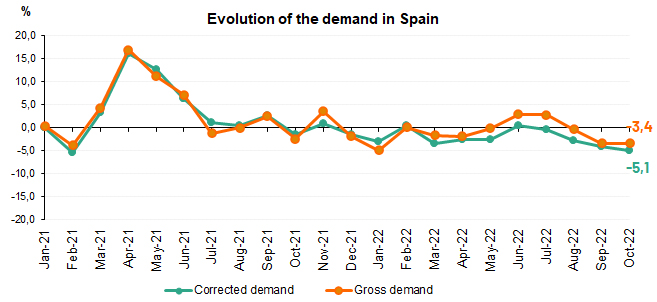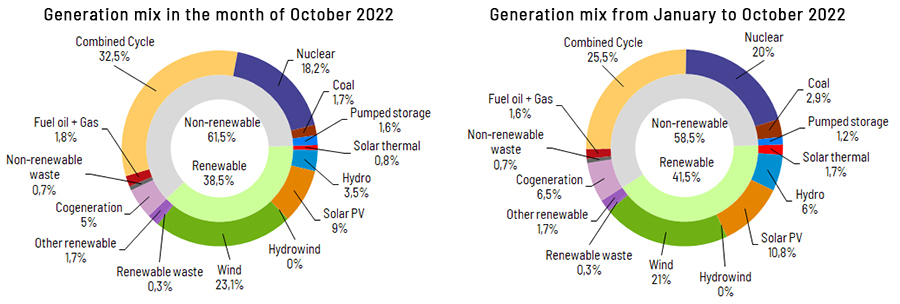For 40 years, we've been driving our country's economic and social progress. Four decades shaping Spain.
Demand for electricity in Spain fell 5.1% in October
- This decrease was observed after having factored in the influence of seasonal and working patterns during the month
- In gross terms, demand is estimated at 19,505 GWh, thus making it the month of October with the lowest consumption since Red Eléctrica started publishing national electricity demand figures
- 57.6% of Spain’s electricity production was obtained using zero-carbon energy technologies, a figure driven by renewable generation, which increased by 6.8% compared to the same month in 2021 and accounted for 38.5% of the total generation mix
After having factored in the influence of seasonal and working patterns, national electricity demand decreased by 5.1% in October compared to the same month last year. In gross terms, demand is estimated at 19,505 GWh, down 3.4% on October 2021, thus making it the month of October with the lowest consumption figure registered since Red Eléctrica started publishing national demand figures.

The behaviour of demand in October confirms the downward trend also observed in the previous months. Thus, in the first ten months of 2022, according to provisional data, after having factored in the influence of seasonal and working patterns, demand is 2.4% lower than that recorded in the same period the previous year.
According to data estimated at the time of this press release, renewables generated 6.8% more electricity this October than in the same month in 2021, registering 8,520 GWh, representing a share of 38.5% of the total generation mix nationwide for the month. On the other hand, 57.6% of electricity production in October was obtained using zero-carbon energy technologies.
Wind power generation in October stood at 5,117 GWh and represented 23.1% of the total, an increase of 17.5% compared to October 2021. Meanwhile, solar photovoltaic, which accounted for 1,999 GWh this month, increased its production by 12.9% compared to last year, reaching a share of 9% of the total generation mix nationwide. For its part, hydroelectric generation fell by 25% compared to October 2021 due to the lack of rainfall during recent months.

Demand for electricity in the peninsular system
After having factored in the influence of seasonal and working patterns, the demand for electrical energy in the mainland electricity system was 5.5% lower than in October last year (18,262 GWh, down 3.8% on that recorded in gross terms in the same month of 2021).
Once again, on the mainland, the downward trend in demand that was also observed in September has been confirmed. In the first ten months of 2022, after having factored in the influence of seasonal and working patterns, demand was 3% lower than in the same period last year.
During October, and according to data estimated at the time of this press release, 39.9% of electricity generation on the mainland came from renewable sources and 60.1% was obtained using zero-carbon energy technologies. Wind power increased by 18.9% compared to 2021 and registered 5,030 GWh, accounting for 24% of the total, while solar photovoltaic, with 9.3% of the generation mix, increased its production by 12.5% compared to the same month last year, to 1,949 GWh.
Demand for electricity in the Balearic Islands and the Canary Islands
Electricity demand in the Balearic Islands during October increased by 3% after having factored in the influence of seasonal and working patterns. In gross terms, monthly demand is estimated at 468,764 MWh, up 5.5% on the figure recorded in October 2021.
In terms of overall generation, combined cycle, with a share of 75% of the total energy produced in the Balearic Islands, was the leading technology in the archipelago in October. Additionally, renewable energy obtained using zero-carbon energy technologies in the Balearic Islands represents 8.6% of the total.
Additionally, during this month the submarine link between the mainland and Majorca contributed to covering 13% of the electricity demand in the Balearic Islands.
Regarding the Canary Islands, electricity demand, having factored in the influence of seasonal and working patterns, increased by 0.8% compared to the same month the previous year. Thus, in gross terms, demand stood at 741,491 MWh, up 1% year-on-year.
With regard to electricity generation in the Canary Islands, combined cycle, with 43.1% of the total generation, was also the leading technology in October, while renewables and zero-carbon energy technologies accounted for 15.6% of production, with wind power representing 11.8% of the total mix on the islands.
Consult our Daily Balance Report for more information on the National, Peninsular, Balearic Islands and Canary Islands electricity systems as at the close of October.
Downloads












